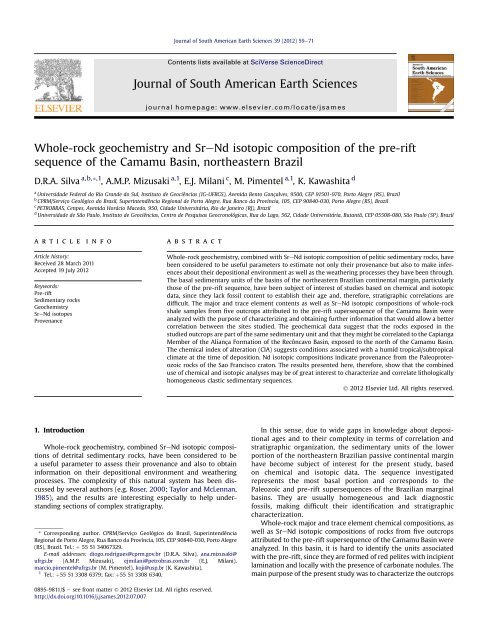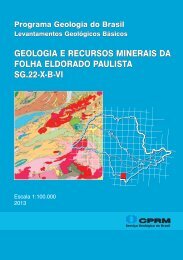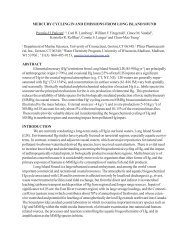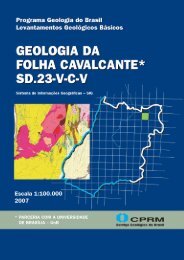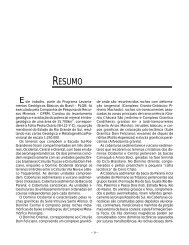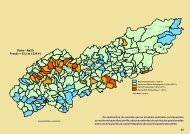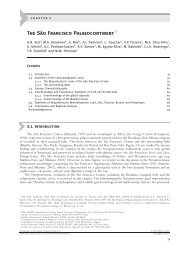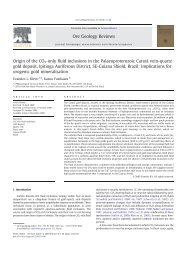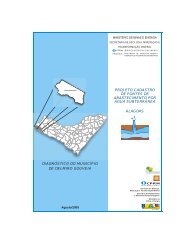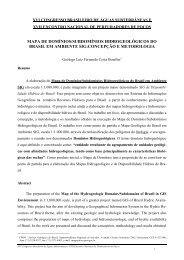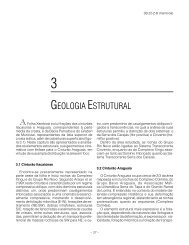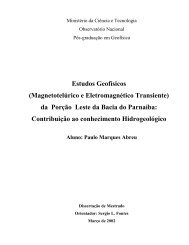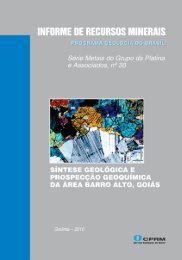Whole-rock geochemistry and Sr-Nd isotopic composition of ... - CPRM
Whole-rock geochemistry and Sr-Nd isotopic composition of ... - CPRM
Whole-rock geochemistry and Sr-Nd isotopic composition of ... - CPRM
You also want an ePaper? Increase the reach of your titles
YUMPU automatically turns print PDFs into web optimized ePapers that Google loves.
<strong>Whole</strong>-<strong>rock</strong> <strong>geochemistry</strong> <strong>and</strong> <strong>Sr</strong>e<strong>Nd</strong> <strong>isotopic</strong> <strong>composition</strong> <strong>of</strong> the pre-rift<br />
sequence <strong>of</strong> the Camamu Basin, northeastern Brazil<br />
D.R.A. Silva a,b, * ,1 , A.M.P. Mizusaki a,1 , E.J. Milani c , M. Pimentel a,1 , K. Kawashita d<br />
a<br />
Universidade Federal do Rio Gr<strong>and</strong>e do Sul, Instituto de Geociências (IG-UFRGS), Avenida Bento Gonçalves, 9500, CEP 91501-970, Porto Alegre (RS), Brazil<br />
b<br />
<strong>CPRM</strong>/Serviço Geológico do Brasil, Superintendência Regional de Porto Alegre, Rua Banco da Província, 105, CEP 90840-030, Porto Alegre (RS), Brazil<br />
c<br />
PETROBRAS, Cenpes, Avenida Horácio Macedo, 950, Cidade Universitária, Rio de Janeiro (RJ), Brazil<br />
d<br />
Universidade de São Paulo, Instituto de Geociências, Centro de Pesquisas Geocronológicas, Rua do Lago, 562, Cidade Universitária, Butantã, CEP 05508-080, São Paulo (SP), Brazil<br />
article info<br />
Article history:<br />
Received 28 March 2011<br />
Accepted 19 July 2012<br />
Keywords:<br />
Pre-rift<br />
Sedimentary <strong>rock</strong>s<br />
Geochemistry<br />
<strong>Sr</strong>e<strong>Nd</strong> isotopes<br />
Provenance<br />
1. Introduction<br />
abstract<br />
<strong>Whole</strong>-<strong>rock</strong> <strong>geochemistry</strong>, combined <strong>Sr</strong>e<strong>Nd</strong> <strong>isotopic</strong> <strong>composition</strong>s<br />
<strong>of</strong> detrital sedimentary <strong>rock</strong>s, have been considered to be<br />
a useful parameter to assess their provenance <strong>and</strong> also to obtain<br />
information on their depositional environment <strong>and</strong> weathering<br />
processes. The complexity <strong>of</strong> this natural system has been discussed<br />
by several authors (e.g. Roser, 2000; Taylor <strong>and</strong> McLennan,<br />
1985), <strong>and</strong> the results are interesting especially to help underst<strong>and</strong>ing<br />
sections <strong>of</strong> complex stratigraphy.<br />
* Corresponding author. <strong>CPRM</strong>/Serviço Geológico do Brasil, Superintendência<br />
Regional de Porto Alegre, Rua Banco da Província, 105, CEP 90840-030, Porto Alegre<br />
(RS), Brazil. Tel.: þ 55 51 34067329.<br />
E-mail addresses: diogo.rodrigues@cprm.gov.br (D.R.A. Silva), ana.mizusaki@<br />
ufrgs.br (A.M.P. Mizusaki), ejmilani@petrobras.com.br (E.J. Milani),<br />
marcio.pimentel@ufrgs.br (M. Pimentel), koji@usp.br (K. Kawashita).<br />
1 Tel.: þ55 51 3308 6379; fax: þ55 51 3308 6340.<br />
0895-9811/$ e see front matter Ó 2012 Elsevier Ltd. All rights reserved.<br />
http://dx.doi.org/10.1016/j.jsames.2012.07.007<br />
Journal <strong>of</strong> South American Earth Sciences 39 (2012) 59e71<br />
Contents lists available at SciVerse ScienceDirect<br />
Journal <strong>of</strong> South American Earth Sciences<br />
journal homepage: www.elsevier.com/locate/jsames<br />
<strong>Whole</strong>-<strong>rock</strong> <strong>geochemistry</strong>, combined with <strong>Sr</strong>e<strong>Nd</strong> <strong>isotopic</strong> <strong>composition</strong> <strong>of</strong> pelitic sedimentary <strong>rock</strong>s, have<br />
been considered to be useful parameters to estimate not only their provenance but also to make inferences<br />
about their depositional environment as well as the weathering processes they have been through.<br />
The basal sedimentary units <strong>of</strong> the basins <strong>of</strong> the northeastern Brazilian continental margin, particularly<br />
those <strong>of</strong> the pre-rift sequence, have been subject <strong>of</strong> interest <strong>of</strong> studies based on chemical <strong>and</strong> <strong>isotopic</strong><br />
data, since they lack fossil content to establish their age <strong>and</strong>, therefore, stratigraphic correlations are<br />
difficult. The major <strong>and</strong> trace element contents as well as <strong>Sr</strong>e<strong>Nd</strong> <strong>isotopic</strong> <strong>composition</strong>s <strong>of</strong> whole-<strong>rock</strong><br />
shale samples from five outcrops attributed to the pre-rift supersequence <strong>of</strong> the Camamu Basin were<br />
analyzed with the purpose <strong>of</strong> characterizing <strong>and</strong> obtaining further information that would allow a better<br />
correlation between the sites studied. The geochemical data suggest that the <strong>rock</strong>s exposed in the<br />
studied outcrops are part <strong>of</strong> the same sedimentary unit <strong>and</strong> that they might be correlated to the Capianga<br />
Member <strong>of</strong> the Aliança Formation <strong>of</strong> the Recôncavo Basin, exposed to the north <strong>of</strong> the Camamu Basin.<br />
The chemical index <strong>of</strong> alteration (CIA) suggests conditions associated with a humid tropical/subtropical<br />
climate at the time <strong>of</strong> deposition. <strong>Nd</strong> <strong>isotopic</strong> <strong>composition</strong>s indicate provenance from the Paleoproterozoic<br />
<strong>rock</strong>s <strong>of</strong> the Sao Francisco craton. The results presented here, therefore, show that the combined<br />
use <strong>of</strong> chemical <strong>and</strong> <strong>isotopic</strong> analyses may be <strong>of</strong> great interest to characterize <strong>and</strong> correlate lithologically<br />
homogeneous clastic sedimentary sequences.<br />
Ó 2012 Elsevier Ltd. All rights reserved.<br />
In this sense, due to wide gaps in knowledge about depositional<br />
ages <strong>and</strong> to their complexity in terms <strong>of</strong> correlation <strong>and</strong><br />
stratigraphic organization, the sedimentary units <strong>of</strong> the lower<br />
portion <strong>of</strong> the northeastern Brazilian passive continental margin<br />
have become subject <strong>of</strong> interest for the present study, based<br />
on chemical <strong>and</strong> <strong>isotopic</strong> data. The sequence investigated<br />
represents the most basal portion <strong>and</strong> corresponds to the<br />
Paleozoic <strong>and</strong> pre-rift supersequences <strong>of</strong> the Brazilian marginal<br />
basins. They are usually homogeneous <strong>and</strong> lack diagnostic<br />
fossils, making difficult their identification <strong>and</strong> stratigraphic<br />
characterization.<br />
<strong>Whole</strong>-<strong>rock</strong> major <strong>and</strong> trace element chemical <strong>composition</strong>s, as<br />
well as <strong>Sr</strong>e<strong>Nd</strong> <strong>isotopic</strong> <strong>composition</strong>s <strong>of</strong> <strong>rock</strong>s from five outcrops<br />
attributed to the pre-rift supersequence <strong>of</strong> the Camamu Basin were<br />
analyzed. In this basin, it is hard to identify the units associated<br />
with the pre-rift, since they are formed <strong>of</strong> red pelites with incipient<br />
lamination <strong>and</strong> locally with the presence <strong>of</strong> carbonate nodules. The<br />
main purpose <strong>of</strong> the present study was to characterize the outcrops
60<br />
<strong>and</strong> to obtain further data to allow a better correlation between<br />
them.<br />
2. Geologic context<br />
The Camamu Basin is located along the coastline <strong>of</strong> Bahia state,<br />
between parallels 13 <strong>and</strong> 14 S, <strong>and</strong> it forms the southern extension<br />
<strong>of</strong> the Recôncavo-Tucano-Jatobá rift system (Fig. 1) With an area <strong>of</strong><br />
about 13,000 km 2 (<strong>of</strong> which emerged 2000 km 2 ), the Camamu<br />
Basin contains some accumulations <strong>of</strong> oil <strong>and</strong> gas on l<strong>and</strong> <strong>and</strong><br />
<strong>of</strong>fshore, all considered to originate from Eocretaceous lacustrine<br />
source <strong>rock</strong>s <strong>of</strong> the Morro do Barro Formation (Gonçalves et al.,<br />
2000).<br />
To the north, the limits between the Camamu Basin <strong>and</strong> the<br />
Recôncavo <strong>and</strong> Jacuípe basins is marked by the Barra Fault, an<br />
important EeW structural regional feature. The Camamu <strong>and</strong><br />
Jacuípe basins overlie Precambrian <strong>rock</strong>s <strong>of</strong> the São Francisco craton<br />
exposed to the west. To the south, the border with the Almada<br />
Basin is only geographic, since structural <strong>and</strong> stratigraphic continuities<br />
between these basins are observed.<br />
The origin <strong>of</strong> the Camamu Basin, as well as <strong>of</strong> the other Meso-<br />
Cenozoic basins <strong>of</strong> the Brazilian continental margin, is correlated<br />
with crustal stretching, which climaxed during Gondwana breakup<br />
<strong>and</strong> the formation <strong>of</strong> the Atlantic Ocean (Ponte <strong>and</strong> Asmus, 1976;<br />
Asmus <strong>and</strong> Guazelli, 1981; Chang et al., 1992).<br />
The crystalline basement <strong>of</strong> the Camamu Basin is part <strong>of</strong> the São<br />
Francisco craton (Almeida, 1977). It is characterized by the<br />
geotectonic units included in the so-called Jequié <strong>and</strong> Itabuna-<br />
Salvador-Curaçá blocks (Barbosa <strong>and</strong> Sabaté, 2002, 2003). These<br />
Archean <strong>and</strong> Paleoproterozoic terrains are, therefore, potential<br />
source areas <strong>of</strong> the detrital sedimentary <strong>rock</strong>s <strong>of</strong> the Camamu basin.<br />
According to Caixeta et al. (2007), the sedimentary package <strong>of</strong><br />
the Camamu Basin comprises five supersequences: Paleozoic, prerift,<br />
rift, post-rift, <strong>and</strong> drift (Fig. 2).<br />
D.R.A. Silva et al. / Journal <strong>of</strong> South American Earth Sciences 39 (2012) 59e71<br />
Fig. 1. Location <strong>of</strong> the Camamu Basin, northeast Brazil.<br />
The tectono-sedimentary evolution <strong>of</strong> the Camamu Basin might<br />
be described as a succession <strong>of</strong> stages: (1) syneclyse, which<br />
precedes the development <strong>of</strong> the continental margin <strong>and</strong><br />
comprises continental <strong>and</strong> marine sediments <strong>of</strong> Permian age <strong>and</strong><br />
which correspond, in lithostratigraphic terms, to the Afligidos<br />
Formation; (2) pre-rift sequence, comprising the fluvial-lacustrine<br />
sediments <strong>of</strong> Jurassic/Eocretaceous age <strong>of</strong> the Aliança, Sergi <strong>and</strong><br />
Itaípe formations; (3) rift sequence, represented by Eocretaceous<br />
lacustrine deposits <strong>of</strong> the Morro do Barro <strong>and</strong> Rio de Contas<br />
formations; (4) post-rift sequence, which was deposited in an<br />
environment <strong>of</strong> asag-type basin, represented by Aptian transitional<br />
sediments <strong>of</strong> the Taipus-Mirim Formation; <strong>and</strong> (4) drift sequence,<br />
including the marine strata <strong>of</strong> Cretaceous to Tertiary age <strong>of</strong> the<br />
Algodões, Urucutuca, Rio Doce <strong>and</strong> Caravelas formations (Netto <strong>and</strong><br />
Ragagnin, 1990; Gonçalves et al., 2000).<br />
The pre-rift sequence e <strong>of</strong> Dom João e Rio da Serra (Neojurassic)<br />
age e was originally distributed over a large geographic<br />
area, comprising the Afro-Brazilian Depression (Estrella, 1972).<br />
Lithostratigraphically, the pre-rift section <strong>of</strong> the Camamu Basin<br />
corresponds to the Brotas Group <strong>and</strong> to the Santo Amaro Group.<br />
The Brotas Group includes the Aliança (Boipeba <strong>and</strong> Capianga<br />
members) <strong>and</strong> Sergi formations, whereas the Santo Amaro Group<br />
is composed <strong>of</strong> the Itaparica, Água Gr<strong>and</strong>e, <strong>and</strong> C<strong>and</strong>eias<br />
formations.<br />
According to Caixeta et al. (2007), the sedimentation <strong>of</strong> this<br />
sequence is characterized by s<strong>and</strong>y clastic sediments <strong>and</strong> shales<br />
deposited by interlaced rivers, with aeolian reworking. Lacustrine<br />
transgressions <strong>of</strong> regional nature are expressed by a predominantly<br />
pelitic sedimentation, which characterizes the Capianga Member<br />
(Aliança Formation) <strong>and</strong> the Itaparica Formation.<br />
The sedimentation <strong>of</strong> this stage is characteristically formed <strong>of</strong><br />
oxidized, reddish sediments. In northeastern Brazil, the pre-rift<br />
sedimentation took place in the Afro-Brazilian Depression, named<br />
by Cesero <strong>and</strong> de Ponte (1972 apud Cesero <strong>and</strong> de Ponte, 1997) <strong>and</strong>
Fig. 2. Stratigraphic chart <strong>of</strong> the Camamu Basin (modified from Caixeta et al., 2007).<br />
which comprised the area currently occupied by the Sergipe-<br />
Alagoas, Camamu <strong>and</strong> Almada basins, in the southern coast <strong>of</strong> the<br />
state <strong>of</strong> Bahia, including also the Recôncavo, Tucano <strong>and</strong> Jatobá<br />
basins <strong>and</strong> their African counterparts. Stratigraphically, the units<br />
<strong>of</strong> the pre-rift sequence <strong>of</strong> the basins <strong>of</strong> the Afro-Brazilian<br />
Depression are considered to be correlated with each other <strong>and</strong><br />
<strong>of</strong> Neojurassic age.<br />
3. Methodology<br />
3.1. Samples analyzed <strong>and</strong> analytical procedures<br />
The samples used in the present study were collected at five<br />
different outcrops in the Camamu Basin (Camamu 1, 2, 3, 4, <strong>and</strong> 5<br />
sampling sites). The sedimentary <strong>rock</strong>s exposed in these outcrops<br />
have been considered to be part <strong>of</strong> the same sedimentary unit, an<br />
assumption that will be investigated here. The precise location <strong>of</strong><br />
the sampling sites is shown in Fig. 3.<br />
It must be highlighted that due to its stratigraphic location,<br />
<strong>rock</strong>s in the Camamu 4 outcrop (Fig. 4) were considered to belong<br />
to the Aliança Formation, Capianga Member (pre-rift supersequence).<br />
However, as shown in Fig. 4, there is a local contact<br />
with sediments identified as belonging to the Sergi Formation<br />
(Fig. 2).<br />
In all outcrops, the <strong>rock</strong>s are described as reddish pelite with<br />
incipient plane-parallel lamination, locally with carbonate<br />
nodules <strong>and</strong> associated with a fluvial-lacustrine depositional<br />
environment.<br />
D.R.A. Silva et al. / Journal <strong>of</strong> South American Earth Sciences 39 (2012) 59e71 61<br />
Efforts were made to collect pelites that visually showed<br />
a smaller degree <strong>of</strong> weathering. However, the samples always<br />
showed evidence <strong>of</strong> intensive weathering processes <strong>and</strong> oxidation.<br />
Macroscopically, the samples collected at the five sampling sites are<br />
reddish argillites, locally with carbonate nodules always with the<br />
presence <strong>of</strong> white mica fragments.<br />
Approximately 500e700 g <strong>of</strong> <strong>rock</strong> were collected from each<br />
sampling site. Care was taken not to contaminate the samples<br />
with fragments from other units; carbonate nodules were<br />
rejected. A minimum <strong>of</strong> four samples was collected at each<br />
outcrop, always maintaining a minimum distance <strong>of</strong> 1 m<br />
horizontally between each sample, according to the methodology<br />
described by Thomaz Filho <strong>and</strong> Lima (1979).<br />
The samples were crushed in an agate mortar <strong>and</strong> dried at<br />
62<br />
Sample preparation followed the procedures described by Alves<br />
(1987), with slides undergoing three preparations, from which<br />
three spectra were obtained (st<strong>and</strong>ard, glycolated, <strong>and</strong> calcined);<br />
their combined interpretation was used to identify the clay<br />
minerals present in the samples, since their physical <strong>and</strong> chemical<br />
characteristics show different responses to the treatments.<br />
After these procedures, we performed the analyses, compared<br />
the diffractograms, <strong>and</strong> identified the clay minerals by st<strong>and</strong>ard<br />
Fig. 4. Picture showing the Camamu 4 outcrop.<br />
D.R.A. Silva et al. / Journal <strong>of</strong> South American Earth Sciences 39 (2012) 59e71<br />
Fig. 3. Camamu Basin area showing the sample location.<br />
procedure according to Brown <strong>and</strong> Brindley (1980) from the<br />
measure <strong>of</strong> the height <strong>of</strong> the major peaks.<br />
4. Results<br />
4.1. Classification <strong>and</strong> <strong>composition</strong> <strong>of</strong> the <strong>rock</strong>s analyzed<br />
Macroscopically <strong>and</strong> as described previously, the samples<br />
investigated were reddish pelites, locally with carbonate nodules,<br />
always with white mica fragments.<br />
Clay fractions <strong>of</strong> the Camamu 2, 3, 4, <strong>and</strong> 5 samples are constituted<br />
mainly <strong>of</strong> illite (I), smectite (S), interstratified illite-smectite<br />
(IS) as traces, <strong>and</strong> possibly quartz <strong>and</strong> K-feldspar. Kaolinite (K),<br />
illite (I), <strong>and</strong> quartz traces prevailed in the Camamu 1 samples.<br />
The <strong>rock</strong>s analyzed were classified according to the method<br />
proposed by Herron (1988), which, according to Roddaz et al.<br />
(2006), is appropriate for clastic clay <strong>rock</strong>s (Fig. 5).<br />
In the present proposition, most samples analyzed can be classified<br />
as Fe-shales. These samples are characterized by high levels<br />
<strong>of</strong> Fe2O3 (8e12%, Table 1). Following Kasanzu et al. (2008), this is<br />
a good descriptive classification to these <strong>rock</strong>s.<br />
4.2. 87 <strong>Sr</strong>/ 86 <strong>Sr</strong> ratios <strong>and</strong> the “pseudo-isochrons”<br />
Initially, the 87 <strong>Sr</strong>/ 86 <strong>Sr</strong> <strong>and</strong> 87 Rb/ 86 <strong>Sr</strong> results were plotted in an<br />
isochron diagram (according to the model <strong>of</strong> Ludwig, 2003). The<br />
purpose was to the verify the possibility <strong>of</strong> establishing the depositional<br />
age, since this method has been successfully applied to
Table 1<br />
Chemical <strong>composition</strong> <strong>of</strong> the Camamu Basin samples (oxides in % <strong>of</strong> weight, trace elements in ppm, <strong>and</strong> CIA in %).<br />
Sample Major element Trace element CIA<br />
SiO2 Al2O3 TiO2 Fe2O3 (T) MnO MgO CaO Na2O K2O P2O5 P.F. Total Y Pb Ni Co Cu Ga <strong>Sr</strong> Zr Zn Nb Rb As Cr Ba<br />
Camamu 1<br />
VA 01 56.1 19.6 1.16 11.31 0.04 1.25 0 0 2.4 0.02 7.3 99.08 81 43 60 107 55 74 40 477 108 132 428 19 266 711 89.30<br />
VA 02 54.8 21.4 1.04 9.73 0.02 1.24 0.08 0 1.8 0.06 8.3 98.49 69 65 60 72 50 56 74 528 98 115 355 25 189 1082 92.01<br />
VA 03 62 13.8 1.35 12.08 0.04 1.25 0 0.44 2.6 0.02 5.3 98.83 96 35 60 118 51 79 43 578 114 149 460 21 355 810 82.22<br />
VA 04 57.7 20.4 1.06 9.75 0.04 1.33 0 0 2.3 0.07 7.8 100.4 88 57 60 78 54 58 86 486 142 119 400 24 226 1075 89.81<br />
VA 05 55.5 21.7 0.92 8.74 0.03 1.48 0.09 0 2 0.1 8.3 98.87 85 75 15 57 53 53 105 467 140 105 354 28 167 1134 91.13<br />
VA 06 57.5 20.8 1 8.73 0.04 1.32 0 0 2.2 0.06 8 99.7 76 68 16 61 50 56 75 524 138 106 373 25 166 927 90.33<br />
VA 07 58.3 20.3 1.01 8.67 0.03 1.15 0 0 2 0.06 7.6 99.1 70 76 15 59 49 52 72 575 139 108 350 27 182 912 91.03<br />
VA 08 55.7 21.8 0.93 8.65 0.03 1.59 0.09 0 2.2 0.11 8.2 99.28 87 53 16 57 48 53 112 453 101 103 372 22 151 1333 90.54<br />
VA 09 55.4 20.3 1.16 10.9 0.03 1.61 0.08 0 2.5 0.02 7.4 99.32 87 44 60 94 53 72 49 509 113 126 447 19 243 725 88.86<br />
VA 10 55.4 20.8 1.06 9.76 0.03 1.61 0.08 0 2.3 0.08 7.8 98.99 91 66 19 74 49 59 91 489 111 120 413 25 213 1030 89.59<br />
VA 11 57.5 19.9 1.09 9.51 0.04 1.26 0 0 2.3 0.03 7.3 99 73 43 17 72 47 60 43 523 101 118 398 18 195 716 89.70<br />
VA 12 57.9 20.9 0.93 8.01 0.04 1.28 0 0 2.2 0.1 7.8 99.06 69 46 17 49 47 49 93 468 99 97 352 20 176 1066 90.62<br />
VA 13 57 22 0.87 7.59 0.04 1.34 0 0 2.2 0.11 8.2 99.29 69 56 17 46 47 46 106 446 102 92 345 22 158 1277 91.03<br />
VA 14 56.6 21.5 0.99 8.74 0.05 1.66 0 0 2.6 0.07 7.8 100.1 81 47 20 62 56 53 78 469 129 104 405 20 175 952 89.30<br />
VA 15 58.5 19.7 0.94 8.28 0.04 1.4 0 0 2.3 0.02 7.2 98.31 58 39 18 56 46 53 37 367 93 98 374 15 174 649 89.45<br />
VA 16<br />
Camamu 2<br />
57 21.6 0.91 8.12 0.04 1.38 0 0.49 2.2 0.11 8 99.89 77 59 23 53 49 50 109 464 109 92 357 23 162 1257 88.80<br />
VA 17 62.2 18 0.9 7.02 0.1 2.37 0 0 5.2 0.13 5.5 101.3 177 31 77 51 111 42 258 251 219 82 510 17 204 3037 77.64<br />
VA 18 60.5 16 1.02 8.07 0.19 2.68 0 0 5.1 0.03 5.1 98.58 186 36 75 70 120 51 158 258 264 95 590 17 262 2707 76.00<br />
VA 19 57.6 17.9 0.95 7.63 0.07 2.55 0 0 4.5 0.06 7 98.18 208 35 71 61 117 46 163 246 228 92 557 15 240 2300 79.96<br />
VA 20 57.2 19.1 0.95 8.13 0.15 2.82 0 0 4.5 0.08 6.8 99.63 235 38 73 78 129 54 177 239 241 100 563 17 245 2563 81.07<br />
VA 21 56.8 18.6 1.02 8.77 0.09 2.56 0 0 4.1 0.04 6.7 98.68 251 35 71 82 133 56 93 245 229 108 568 16 327 1854 81.93<br />
VA 22 57.6 18.5 1.06 9.14 0.06 2.6 0 0.44 4.2 0.04 6.9 100.6 255 34 67 89 136 59 86 251 233 116 577 17 279 1788 80.11<br />
VA 23 60.5 17.6 1.02 8.52 0.08 2.48 0 0.44 4.1 0.06 6.7 101.4 266 35 60 81 127 54 108 265 206 111 575 17 267 1816 79.60<br />
VA 24 56.9 20.2 0.86 7.59 0.12 2.51 0 0 4 0.11 7.2 99.41 287 37 83 68 137 48 151 234 221 104 557 16 206 2703 83.45<br />
VA 25 55.4 19.5 0.94 8.43 0.47 2.59 0 0.22 3.9 0.14 7.4 98.93 286 36 84 245 160 55 153 238 217 111 556 17 213 3218 82.71<br />
VA 26 55.7 19.2 0.94 9.16 0.47 2.65 0 0.36 3.8 0.09 7.3 99.8 311 46 92 160 177 58 109 238 244 119 572 18 236 2624 82.07<br />
VA 27 57 19.7 0.96 7.75 0.14 2.44 0 0 3.7 0.13 7.3 99.2 280 35 77 91 140 49 132 255 227 107 512 14 239 3556 84.25<br />
VA 28 56.6 20 0.95 7.69 0.13 2.27 0 0.47 3.5 0.19 7.5 99.35 253 34 71 74 123 50 136 258 201 103 482 14 218 4519 83.30<br />
VA 29 56 21.6 0.91 7.78 0.14 2.11 0 0 3.5 0.08 7.7 99.75 160 41 52 139 116 55 107 246 143 94 466 15 240 1904 86.01<br />
VA 30 56.2 20.8 1.02 8.23 0.07 2.16 0 0 3.4 0.07 7.2 99.14 159 38 51 98 123 54 106 257 150 98 461 17 247 1615 85.78<br />
VA 31<br />
Camamu 3<br />
56.8 21 0.93 7.47 0.07 2.08 0 0 3.4 0.13 7.5 99.29 161 37 51 71 120 50 116 262 152 91 455 15 229 2839 86.12<br />
VA 32 54.1 20.9 0.89 8.77 0.03 2.33 0 0 4.4 0.11 7.8 99.15 134 40 31 62 99 61 97 246 124 95 573 18 238 3023 82.68<br />
VA 33 55.7 20.6 0.9 8.47 0.15 2.4 0 0 4.3 0.15 6.8 99.4 150 45 50 71 120 60 108 243 137 93 561 19 217 3870 82.83<br />
VA 34 55.2 20.9 0.92 8.62 0.04 2.57 0 0 4.4 0.1 6.9 99.68 128 36 41 70 115 61 86 238 147 91 576 16 221 2767 82.65<br />
VA 35 56.4 19.9 0.9 8.35 0.13 2.62 0 0.48 4.4 0.05 7 100.2 127 36 54 79 137 58 67 235 226 91 585 16 233 2167 80.30<br />
VA 36 56.5 18.8 0.96 9.32 0.33 2.89 0.08 0 4.5 0.05 6.4 99.76 142 41 62 136 177 62 73 246 268 98 614 17 247 2438 80.50<br />
VA 37 57.1 20.2 0.85 7.9 0.08 2.79 0 0 4.6 0.12 6.8 100.3 167 40 73 55 148 54 130 231 336 90 582 16 223 3349 81.51<br />
VA 38<br />
Camamu 4<br />
57.1 18.7 0.94 9.36 0.1 2.83 0 0 4.9 0.07 6 99.92 166 43 60 91 117 62 93 240 346 96 653 18 251 2885 79.32<br />
VA 39 55.1 21.9 1.01 8.38 0.02 1.91 0 0 3.4 0.11 7.6 99.42 106 87 47 58 67 54 241 270 129 87 438 27 260 1979 86.41<br />
VA 40 54.5 22 0.97 8.31 0.03 2.07 0 0 3.7 0.06 7.7 99.3 110 35 53 63 77 57 157 254 145 90 467 16 267 1510 85.68<br />
VA 41 56.9 19.7 0.91 7.7 0.06 2.52 0 0 5 0.08 6.1 99.35 193 27 66 57 100 49 237 240 207 92 586 12 240 2963 79.80<br />
VA 42 57.7 19.3 0.9 7.73 0.08 2.6 0 0 5.5 0.06 5.7 99.6 193 31 69 60 93 47 223 239 216 91 566 13 218 2558 77.94<br />
VA 43 57.9 17.9 0.91 7.77 0.08 2.63 0 0.44 6.3 0.02 4.9 98.85 168 30 71 59 80 46 160 224 221 86 573 13 218 2505 72.62<br />
VA 44 59.3 18.3 0.88 7.31 0.05 2.6 0 0 6.6 0.19 5 100.1 195 27 71 49 80 44 368 239 223 89 544 12 202 5074 73.44<br />
VA 45 58.4 18.2 0.94 7.88 0.1 2.73 0 0 6.3 0.02 5.1 99.6 151 33 73 62 85 50 160 232 229 86 589 13 235 2500 74.26<br />
VA 46 57.7 18 0.91 7.47 0.06 2.62 0 0.43 6.4 0.06 4.8 98.44 144 26 66 51 82 47 240 238 204 84 556 11 211 2653 72.49<br />
VA 47 57.8 18.1 0.87 7.76 0.25 2.54 0 0.46 6.7 0.09 4.9 99.37 143 31 72 55 88 47 247 218 208 82 591 13 204 3277 71.63<br />
VA 48 56.6 19.3 0.93 7.32 0.02 2.41 0 0.4 5.4 0.12 6 98.47 105 31 54 43 72 47 299 249 179 78 580 13 216 3453 77.01<br />
VA 49 57 20.3 1.02 7.33 0.02 2.32 0 0.46 4.1 0.14 6.5 99.19 123 36 59 49 81 50 300 283 176 86 524 13 245 3619 81.70<br />
VA 50 56.3 19.8 1.02 8.12 0.03 2.38 0 0 4.4 0.23 6.5 98.68 177 34 61 55 92 53 411 275 195 94 564 15 244 5399 81.96<br />
(continued on next page)<br />
D.R.A. Silva et al. / Journal <strong>of</strong> South American Earth Sciences 39 (2012) 59e71 63
64<br />
Table 1 (continued )<br />
Sample Major element Trace element CIA<br />
SiO2 Al2O3 TiO2 Fe2O3 (T) MnO MgO CaO Na2O K2O P2O5 P.F. Total Y Pb Ni Co Cu Ga <strong>Sr</strong> Zr Zn Nb Rb As Cr Ba<br />
VA 51 54.3 20.4 0.93 8.06 0.48 2.5 0 0 4.7 0.33 6.8 98.44 257 34 115 80 114 47 514 252 250 99 575 16 236 8965 81.36<br />
VA 52 56.1 19.3 1.06 8.48 0.1 2.57 0 0 4.9 0.05 6.7 99.26 222 29 76 68 106 57 194 259 221 106 590 15 268 2656 79.69<br />
VA 53 56 20.4 0.97 7.14 0.04 2.4 0 0 4.6 0.11 6.9 98.52 213 31 69 47 88 47 311 272 183 95 527 12 221 3186 81.66<br />
Camamu 5<br />
CA 01 56.8 20.5 0.77 8.43 0.02 2.61 0.12 0 3.8 0.1 7.8 100.9 3 26 27 53 61 55 96 253 159 105 569 17 149 853 83.95<br />
CA 02 56.9 20.4 0.82 8.49 0.02 2.58 0.12 0 4 0.11 7.7 101.1 150 24 27 52 56 61 195 271 151 105 588 18 153 1673 83.09<br />
CA 03 56.8 20.1 0.78 8.79 0.03 2.44 0.12 0 3.7 0.13 7.9 100.8 143 29 21 57 47 54 173 261 136 103 553 18 150 2154 84.20<br />
CA 04 61.1 18.1 0.86 7.63 0.09 2.04 0 0 3.3 0 7.3 100.4 105 28 18 45 43 50 121 322 112 100 465 18 137 1264 84.61<br />
CA 05 60.1 18.1 0.89 7.96 0.02 2.18 0.08 0.33 3.2 0.08 7.1 100 101 34 17 45 41 54 130 349 117 101 474 18 142 1208 83.43<br />
CA 06 57.9 19.6 0.82 7.08 0.02 1.96 0 0 3.1 0.13 7.9 98.55 87 22 15 36 41 48 170 338 114 94 429 14 139 1416 86.25<br />
CA 07 59.4 17.4 0.91 9.04 0.02 2.13 0 0 3.6 0.1 6.6 99.15 116 39 20 62 54 57 124 309 161 114 540 21 164 1208 82.78<br />
CA 08 61.6 19 0.82 5.99 0.02 2.07 0 0 3 0.14 7.3 99.82 109 36 27 24 64 41 179 355 153 92 426 12 128 1989 86.46<br />
CA 09 60.8 19.2 0.82 5.88 0.02 1.93 0 0 2.9 0.13 8 99.78 88 33 25 21 47 40 165 359 116 88 399 14 124 1686 86.94<br />
CA 10 59.2 19.1 0.82 6.25 0.02 1.89 0 0 3.2 0.11 7.8 98.39 99 36 17 27 37 48 185 325 129 90 451 14 120 2081 85.71<br />
CA 11 56.7 18.7 0.83 8.89 0.02 2.38 0.08 0 3.6 0.08 7.8 98.93 126 33 22 60 62 56 110 273 194 107 623 22 152 1138 83.52<br />
CA 12 55.7 18.8 0.84 9.39 0.02 2.18 0.08 0 3.3 0.17 8.1 98.55 155 34 23 67 70 56 298 289 171 113 534 27 149 2330 84.96<br />
CA 13 59.4 19.7 0.78 6 0.02 2.24 0 0.42 3.3 0.12 7.3 99.3 101 32 28 29 48 43 194 301 158 84 478 13 124 2395 84.30<br />
CA 14 58.8 19.4 0.78 6.32 0.02 2.4 0 0.37 3.5 0.12 7.1 98.85 111 33 40 33 54 46 211 298 190 85 521 14 120 2423 83.32<br />
D.R.A. Silva et al. / Journal <strong>of</strong> South American Earth Sciences 39 (2012) 59e71<br />
basal sections <strong>of</strong> basins <strong>of</strong> the Brazilian continental margin, with<br />
results that can be correlated with depositional age (Silva et al.,<br />
2012, 2006).<br />
The Rbe<strong>Sr</strong> radiometric method is traditionally used to assess<br />
the absolute ages in igneous <strong>rock</strong>s. In a sedimentary environment,<br />
characterized by lower temperatures, the behavior <strong>of</strong> Rb <strong>and</strong> <strong>Sr</strong> ions<br />
Table 2<br />
Rb <strong>and</strong> <strong>Sr</strong> <strong>isotopic</strong> ratios <strong>of</strong> the Camamu Basin samples. Error values <strong>of</strong> the isotope<br />
ratios are expressed as absolute SD.<br />
Sample<br />
Camamu 1<br />
87 86<br />
Rb/ <strong>Sr</strong> Error<br />
87 86<br />
<strong>Sr</strong>/ <strong>Sr</strong> Error<br />
VA-01 15.469 0.116 0.81945 0.00015<br />
VA-02 6.191 0.043 0.76890 0.00003<br />
VA-03 14.365 0.107 0.81845 0.00002<br />
VA-04 7.543 0.058 0.76933 0.00003<br />
VA-05 7.302 0.067 0.77884 0.00001<br />
VA-06 4.19 0.027 0.72500 0.00004<br />
VA-07 6.804 0.048 0.76858 0.00005<br />
VA-08 12.395 0.093 0.80415 0.00004<br />
VA-09 4.553 0.032 0.76059 0.00002<br />
VA-10 6.189 0.044 0.76765 0.00002<br />
VA-11 12.313 0.088 0.80169 0.00003<br />
VA-12 5.737 0.047 0.76022 0.00001<br />
VA-13 5.022 0.036 0.76387 0.00001<br />
VA-14 6.895 0.05 0.77663 0.00003<br />
VA-15 14.709 0.115 0.81239 0.00008<br />
VA-16<br />
Camamu 2<br />
4.646 0.033 0.75513 0.00012<br />
VA-17 3.37586 0.0296 0.73878 0.00001<br />
VA-18 6.08820 0.0525 0.75574 0.00001<br />
VA-19 5.65505 0.0476 0.75455 0.00001<br />
VA-20 6.34870 0.0748 0.75451 0.00002<br />
VA-21 8.43510 0.0673 0.77884 0.00002<br />
VA-22 10.42728 0.0877 0.78566 0.00003<br />
VA-23 8.38790 0.0700 0.77145 0.00002<br />
VA-24 6.10938 0.0509 0.76078 0.00001<br />
VA-25 5.69371 0.0474 0.75896 0.00001<br />
VA-26 8.23868 0.0674 0.77485 0.00001<br />
VA-27 6.21649 0.0503 0.76401 0.00002<br />
VA-28 6.66539 0.0555 0.76430 0.00001<br />
VA-29 6.75423 0.0523 0.76818 0.00002<br />
VA-30 6.87681 0.0531 0.76881 0.00002<br />
VA-31<br />
Camamu 3<br />
6.24680 0.0487 0.76605 0.00002<br />
VA-32 9.41782 0.0780 0.77743 0.00003<br />
VA-33 9.18106 0.1465 0.77625 0.00002<br />
VA-34 10.81693 0.0907 0.78804 0.00002<br />
VA-36 13.22064 0.1476 0.80161 0.00002<br />
VA-37 7.00173 0.0585 0.76673 0.00001<br />
VA-38 10.78640 0.0946 0.78903 0.00001<br />
VA-39<br />
Camamu 4<br />
2.70938 0.0207 0.73385 0.00001<br />
VA-40 4.51921 0.0351 0.74477 0.00001<br />
VA-41 4.06828 0.0352 0.73784 0.00000<br />
VA-42 4.05274 0.0345 0.74147 0.00001<br />
VA-43 5.88240 0.0512 0.75513 0.00002<br />
VA-44 2.45589 0.0213 0.73217 0.00001<br />
VA-45 5.97469 0.0519 0.75637 0.00001<br />
VA-46 3.88710 0.0336 0.74028 0.00001<br />
VA-47 3.97380 0.0352 0.74068 0.00001<br />
VA-48 3.25040 0.0282 0.73644 0.00000<br />
VA-49 2.87388 0.02424 0.73581 0.00001<br />
VA-50 2.18201 0.01816 0.73313 0.00000<br />
VA-51 1.82305 0.01573 0.73088 0.00000<br />
VA-53<br />
Camamu 5<br />
3.11844 0.02899 0.73541 0.00001<br />
CA-01 10.24895 0.08824 0.76312 0.00001<br />
CA-02 6.76421 0.08485 0.73842 0.00001<br />
CA-03 4.97022 0.03996 0.74723 0.00001<br />
CA-04 7.32612 0.25619 0.76025 0.00002<br />
CA-05 7.40417 0.16504 0.74251 0.00001<br />
CA-06 3.99433 0.03054 0.73279 0.00001<br />
CA-07 6.67668 0.05331 0.74140 0.00001<br />
CA-08 6.02965 0.06585 0.78556 0.00002
Table 2 (continued )<br />
Sample<br />
87 86<br />
Rb/ <strong>Sr</strong> Error<br />
87 86<br />
<strong>Sr</strong>/ <strong>Sr</strong> Error<br />
CA-09 4.39125 0.03402 0.73161 0.00002<br />
CA-10 4.78777 0.03921 0.73422 0.00001<br />
CA-12 2.67524 0.02124 0.72494 0.00001<br />
CA-13 4.37411 0.03590 0.73156 0.00001<br />
CA-14 4.30932 0.03609 0.73125 0.00001<br />
CA-06 3.99433 0.03054 0.73279 0.00001<br />
CA-07 6.67668 0.05331 0.74140 0.00001<br />
CA-08 6.02965 0.06585 0.78556 0.00002<br />
CA-09 4.39125 0.03402 0.73161 0.00002<br />
CA-10 4.78777 0.03921 0.73422 0.00001<br />
CA-12 2.67524 0.02124 0.72494 0.00001<br />
varies. Rb is more easily adsorbed by clay minerals, whilst <strong>Sr</strong> tends<br />
to be released from the crystalline structure <strong>of</strong> minerals into<br />
interstitial fluids. It is assumed that this feature favors the process<br />
<strong>of</strong> <strong>Sr</strong> isotope homogenization (i.e., isotope homogenization in<br />
sedimentary environment) during sediment deposition (Compston<br />
<strong>and</strong> Pidgeon, 1962; Faure, 1986), a condition required for Rbe<strong>Sr</strong><br />
radiometric dating <strong>of</strong> sedimentary <strong>rock</strong>s.<br />
If the assumption <strong>of</strong> <strong>Sr</strong> isotope homogenization in sediments<br />
during their deposition is valid, successful radiometric dating <strong>of</strong><br />
detrital sedimentary <strong>rock</strong>s using the Rbe<strong>Sr</strong> technique depends e as<br />
pointed out by Mizusaki (1992) <strong>and</strong> Mizusaki et al. (1998) e on the<br />
careful selection <strong>of</strong> samples with a high clay fraction content<br />
formed primarily <strong>of</strong> expansive clay minerals such as smectite <strong>and</strong><br />
interstratified illite-smectite, preferably sampled according to the<br />
recommendations <strong>of</strong> Thomaz Filho <strong>and</strong> Lima (1979).<br />
As shown in Fig. 6, no meaningful isochronic regression line<br />
could be calculated using all results from the <strong>isotopic</strong> ratios obtained<br />
for the five outcrops, due to their great dispersion. Therefore,<br />
a selection <strong>of</strong> points was performed as proposed by Thomaz Filho<br />
<strong>and</strong> Lima (1979). The points selected were plotted once more<br />
with the Isoplot statistical s<strong>of</strong>tware (Ludwig, 2003), resulting in an<br />
isochron age <strong>of</strong> 470 17 Ma (Fig. 7). The <strong>isotopic</strong> values used for<br />
obtaining the isochron are represented mainly by samples from the<br />
Camamu 2, 3, <strong>and</strong> 4 outcrops.<br />
Possible reasons for the scatter <strong>of</strong> the analytical points <strong>of</strong> the<br />
Camamu 1 <strong>and</strong> 5 samples are:<br />
sediment provenance<br />
high level <strong>of</strong> chemical alteration (Table 1) when compared to<br />
the remaining points<br />
slightly different mineralogical <strong>composition</strong>, especially <strong>of</strong> the<br />
Camamu 1 samples; XRD analyses <strong>of</strong> these samples did not<br />
show expansive clay minerals, which favor <strong>isotopic</strong> homogenization<br />
<strong>of</strong> <strong>Sr</strong>.<br />
In order to obtain preliminary information about the provenance<br />
<strong>of</strong> the units, we use a 87 <strong>Sr</strong>/ 86 <strong>Sr</strong> 1/<strong>Sr</strong> diagram, which<br />
indicates contributions from mixed sources. Fig. 8 shows that<br />
the samples are located on the same straight line, indicating<br />
a common source. However, some samples <strong>of</strong> the Camamu 1<br />
<strong>and</strong> 5 outcrops did not fit in <strong>and</strong> align along a different<br />
regression line. This may indicate contribution from a different<br />
source.<br />
The age <strong>of</strong> 470 17 Ma (Fig. 7) is considered here to be too old to<br />
represent the depositional age, in the light <strong>of</strong> the tectonic models<br />
proposed for the Camamu Basin (Caixeta et al., 2007).<br />
Therefore, one may suggest that it represents a “pseudoisochron”,<br />
i.e., with no geochronological significance. Even using<br />
samples collected from the different outcrops <strong>and</strong> positioned in<br />
individual isochrons, no meaningful value was obtained for the<br />
sedimentation age. The values obtained were always older than<br />
expected, considering the current knowledge on this sedimentary<br />
section.<br />
Table 3<br />
Average chemical <strong>composition</strong> <strong>of</strong> samples <strong>of</strong> the Camamu Basin <strong>and</strong> <strong>of</strong> pre-rift sedimentary units <strong>of</strong> the Recôncavo Basin (source: Silva et al., 2012). Oxides in % <strong>of</strong> weight, <strong>and</strong><br />
trace elements in ppm.<br />
Result Outcrop<br />
D.R.A. Silva et al. / Journal <strong>of</strong> South American Earth Sciences 39 (2012) 59e71 65<br />
Camamu Basin Recôncavo Basin<br />
Camamu 1 Camamu 2 Camamu 3 Camamu 4 Camamu 5 Capianga Cazumba Itaparica<br />
Major element SiO2 57.0 57.5 56.0 56.8 58.7 54.5 66.7 48.5<br />
Al2O3 20.4 19.2 20.0 19.5 19.1 17.8 15.9 18.5<br />
TiO2 1.0 1.0 0.9 0.9 0.8 1.1 0.8 1.2<br />
Fe2O3 (T) 9.3 8.1 8.7 7.8 7.6 11.1 6.8 23.8<br />
MnO 0.0 0.2 0.1 0.1 0.0 0.1 0.0 0.0<br />
MgO 1.4 2.5 2.6 2.5 2.2 3.6 1.5 0.5<br />
CaO 0.0 0.0 0.0 0.0 0.0 0.3 0.0 0.1<br />
Na2O 0.1 0.1 0.1 0.1 0.1 0.3 0.1 0.1<br />
K2O 2.2 4.0 4.5 5.2 3.4 3.6 3.0 0.6<br />
P2O5 0.1 0.1 0.1 0.1 0.1 0.1 0.1 0.1<br />
P.F. 7.6 6.9 6.8 6.1 7.6 7.3 5.0 7.5<br />
Total 99.2 99.5 99.8 99.1 99.6 99.7 99.9 100.7<br />
Trace element Y 78.6 231.7 144.9 166.7 106.7 125.8 277.6 49.0<br />
Pb 54.5 36.5 40.1 34.8 31.4 44.5 72.8 96.0<br />
Ni 30.8 70.3 53.0 68.1 23.4 88.9 65.1 0.0<br />
Co 69.7 97.2 80.6 57.1 43.6 108.1 53.7 221.9<br />
Cu 50.3 131.3 130.4 87.0 51.8 209.2 76.2 42.6<br />
Ga 57.7 52.1 59.7 49.5 50.6 49.5 33.3 47.0<br />
<strong>Sr</strong> 75.8 136.9 93.4 270.8 167.9 84.1 125.3 306.7<br />
Zr 488.9 249.5 239.9 249.6 307.4 234.2 380.5 197.4<br />
Zn 114.8 211.7 226.3 199.1 147.2 261.8 235.8 36.9<br />
Nb 111.5 102.1 93.4 89.7 98.6 56.1 58.3 55.1<br />
Rb 386.4 533.4 592.0 551.3 503.6 333.1 382.6 69.8<br />
As 22.1 16.1 17.1 14.3 17.1 11.2 30.4 31.6<br />
Cr 199.9 243.5 232.9 232.3 139.4 236.8 107.0 415.5<br />
Ba 978.5 2602.9 2928.4 3486.5 1701.3 724.8 670.3 504.4<br />
CIA 89.9 82.4 81.3 78.6 84.5 80.9 83.7 95.9
66<br />
Table 4<br />
Sm <strong>and</strong> <strong>Nd</strong> <strong>isotopic</strong> ratios <strong>of</strong> the Camamu Basin samples. Error values <strong>of</strong> the isotope ratios are expressed as absolute SD.<br />
Sample<br />
Camamu 1<br />
147 144<br />
Sm/ <strong>Nd</strong> Error<br />
143 144<br />
<strong>Nd</strong>/ <strong>Nd</strong> Error TDM (Ga) ε<strong>Nd</strong>(0) ε<strong>Nd</strong>(150 Ma)<br />
VA-03 2.7125 0.0161 0.512050 0.000011 11.48<br />
VA-09<br />
Camamu 2<br />
0.8126 0.0052 0.511536 0.000009 21.50<br />
VA-23 0.1630 0.0016 0.511323 0.000015 25.66 25<br />
VA-29<br />
Camamu 3<br />
0.0900 0.0006 0.511441 0.000008 2.0 23.35 21.3<br />
VA-33 0.0897 0.0006 0.511458 0.000013 2.0 23.03 21.0<br />
VA-37<br />
Camamu 4<br />
0.1085 0.0007 0.511569 0.000008 2.1 20.84 19.2<br />
VA-42 0.1234 0.0008 0.511570 0.000012 2.5 20.83 19.4<br />
VA-48<br />
Camamu 5<br />
0.0734 0.0005 0.511547 0.000012 1.6 21.29 18.9<br />
CA-02 0.1437 0.0010 0.511547 0.000011 3.3 21.28 20.3<br />
CA-12 0.0822 0.0005 0.511677 0.000007 1.6 18.74 16.6<br />
Log( Al<br />
2O3 /K2O) 2<br />
1<br />
0<br />
Fe-shales Fe-s<strong>and</strong>s<br />
Shales<br />
Wackes<br />
Lithic<br />
arenites<br />
Arkose<br />
Sub-lithic<br />
arenites<br />
Sub-arkose<br />
Quartz arenites<br />
-1<br />
0 0,5 1 1,5 2 2,5<br />
Log(SiO2/Al2O3) The results obtained can be explained by the abundant presence<br />
<strong>of</strong> detritic muscovite in the samples, even in the fine fraction. Mica<br />
contributed with radiogenic <strong>Sr</strong> from the source <strong>rock</strong>, <strong>and</strong>, moreover,<br />
its structure does not allow <strong>Sr</strong> <strong>isotopic</strong> homogenization<br />
(Mizusaki, 1992), thus, contributing to the anomalously old results.<br />
The results might be, alternatively, attributed to a possible contribution<br />
<strong>of</strong> K-feldspar, according to results <strong>of</strong> the X-ray diffraction<br />
analyses.<br />
Table 2 shows that 87 <strong>Sr</strong>/ 86 <strong>Sr</strong> values are high, evidencing<br />
contributions from fragments <strong>of</strong> old continental <strong>rock</strong>s, whose<br />
source will be verified next.<br />
4.3. Characteristics <strong>of</strong> the whole-<strong>rock</strong> <strong>geochemistry</strong><br />
camamu 1<br />
camamu 2<br />
camamu 3<br />
camamu 4<br />
camamu 5<br />
Capianga<br />
Fig. 5. Chemical classification <strong>of</strong> the analyzed <strong>rock</strong>s (modified from Herron, 1988).<br />
The geochemical <strong>composition</strong> <strong>of</strong> sedimentary <strong>rock</strong>s is a complex<br />
result <strong>of</strong> various variables such as source material, weathering,<br />
transportation, physical sorting, <strong>and</strong> diagenesis (Middleton, 1960;<br />
Piper, 1974; Bhatia, 1983; McLennan, 1989; Cox <strong>and</strong> Lowe, 1995).<br />
87 <strong>Sr</strong>/ 86 <strong>Sr</strong><br />
0.820<br />
0.800<br />
0.780<br />
0.760<br />
0.740<br />
0.720<br />
0 5 10 15 20<br />
87 Rb/ 86 <strong>Sr</strong><br />
Fig. 6. 87 Rb/ 86 <strong>Sr</strong> versus. 87 <strong>Sr</strong>/ 86 <strong>Sr</strong> diagram.<br />
D.R.A. Silva et al. / Journal <strong>of</strong> South American Earth Sciences 39 (2012) 59e71<br />
Camamu 1<br />
Camamu 2<br />
Camamu 3<br />
Camamu 4<br />
Camamu 5<br />
r<br />
S<br />
/<br />
r<br />
S<br />
Examples <strong>of</strong> studies using geochemical data from sediments to<br />
underst<strong>and</strong> sedimentary processes such as weathering, provenance,<br />
diagenesis, sorting, <strong>and</strong> recycling are increasing in the<br />
literature because <strong>of</strong> the sensitiveness <strong>of</strong> some key trace elements<br />
in identifying minor components that are not readily recognized<br />
petrographically (e.g. Hiscott, 1984; Garver et al., 1996).<br />
The chemical <strong>composition</strong> <strong>of</strong> samples represents their primary<br />
mineralogy, which frequently underwent intense pre- <strong>and</strong> post-<br />
87 <strong>Sr</strong>/ 86 <strong>Sr</strong><br />
0.80<br />
0.78<br />
0.76<br />
0.74<br />
0.72<br />
0 2 4 6 8 10 12<br />
0.83<br />
0.80<br />
0.77<br />
0.74<br />
+ Camamu 2<br />
Camamu 3<br />
Camamu 4<br />
+<br />
0.71<br />
0 0.01 0.02 0.03<br />
1/<strong>Sr</strong><br />
+ +<br />
Rb/ <strong>Sr</strong><br />
Fig. 8. 87 <strong>Sr</strong>/ 86 <strong>Sr</strong> (ratio) versus 1/<strong>Sr</strong> (concentration) diagram.<br />
+<br />
Age = 470 ± 17 Ma<br />
Initial <strong>Sr</strong>/ <strong>Sr</strong> = 0.7154 ± 0.001<br />
MSWD = 54<br />
Fig. 7. isochron for the samples <strong>of</strong> the Camamu Basin, according to Ludwig’s model<br />
(2003).<br />
+<br />
camamu 1<br />
camamu 2<br />
camamu 3<br />
camamu 4<br />
camamu 5
depositional chemical weathering processes (Nesbitt <strong>and</strong> Young,<br />
1982). According to Button <strong>and</strong> Tyler (1979), cations such as Al, K,<br />
Mg, <strong>and</strong> Rb are always retained in weathering pr<strong>of</strong>iles, while<br />
cations <strong>of</strong> smaller ionic range, such as Na, Ca, <strong>and</strong> <strong>Sr</strong>, are rapidly<br />
SiO2 Fe O 3<br />
MgO<br />
a O<br />
N 2<br />
2<br />
P O5<br />
2<br />
D.R.A. Silva et al. / Journal <strong>of</strong> South American Earth Sciences 39 (2012) 59e71 67<br />
O<br />
a<br />
C<br />
O<br />
K 2<br />
TiO2 MnO<br />
Fig. 9. Variations <strong>of</strong> major elements (%) versus Al2O3 (%).<br />
leached <strong>and</strong> removed from the system. In addition, the amount <strong>of</strong><br />
elements that is lost is proportional to the extent <strong>of</strong> the weathering<br />
processes. Table 1 shows the results <strong>of</strong> XRF analyses <strong>of</strong> samples<br />
from selected outcrops <strong>of</strong> the Camamu Basin.
68<br />
Y<br />
i<br />
N<br />
u<br />
C<br />
r<br />
S<br />
Zn<br />
b<br />
R<br />
r<br />
C<br />
D.R.A. Silva et al. / Journal <strong>of</strong> South American Earth Sciences 39 (2012) 59e71<br />
b<br />
P<br />
o<br />
C<br />
Ga<br />
Zr<br />
b<br />
N<br />
s<br />
A<br />
a<br />
B<br />
Fig. 10. Variations <strong>of</strong> trace elements (ppm) versus Al2O3 (%).
The diagrams were initially drawn based on the abundance <strong>of</strong><br />
Al2O3 <strong>and</strong> taking into account that the samples come from<br />
predominantly clay-rich <strong>rock</strong>s. According to Weaver (1989), clays<br />
preserve source <strong>rock</strong> chemical signatures due to the fact their<br />
mineralogy is rarely affected by post-depositional processes as<br />
diagenesis or metamorphosis. The variance diagrams for the<br />
samples are shown in Figs. 9 <strong>and</strong> 10.<br />
This suggests that the abundance <strong>of</strong> elements is controlled by<br />
the content <strong>of</strong> clay minerals. Pelites have higher K2O <strong>and</strong> are<br />
depleted in Na2O, revealing a higher proportion <strong>of</strong> clay minerals,<br />
especially illite <strong>and</strong> interstratified illite-smectite, according to XRD<br />
analyses.<br />
Although potassium is thought to be highly soluble in water, it<br />
tends to be conserved in some pelites because <strong>of</strong> the chemical<br />
stability <strong>of</strong> illite (Norrish <strong>and</strong> Pickering, 1983). Illite is relatively<br />
resistant to weathering <strong>and</strong> is potentially stable in soils except<br />
under extreme weathering conditions.<br />
CaO values are very low (Table 1), suggesting very fast alteration<br />
<strong>of</strong> plagioclase, according to the criteria <strong>of</strong> Roser (2000). No traces <strong>of</strong><br />
plagioclase were found in the fine fraction <strong>of</strong> the samples.<br />
TiO2 <strong>and</strong> Al2O3 are refractory oxides that are highly resistant to<br />
weathering in all but the most extreme environments, for example<br />
in long-lived weathering pr<strong>of</strong>iles in hot <strong>and</strong> humid conditions (Hill<br />
et al., 2000). This geochemical information contrasts with CaO,<br />
Na2O <strong>and</strong> <strong>Sr</strong>, which are relatively mobile <strong>and</strong> can be easily lost from<br />
pelites. On the other h<strong>and</strong>, Rb tends to be incorporated into clay<br />
minerals by adsorption <strong>and</strong> cation exchange during chemical<br />
weathering <strong>of</strong> fresh continental <strong>rock</strong> (Nesbitt et al., 1980). There is<br />
a strong negative correlation between Na2O <strong>and</strong> Rb which indicates<br />
that clay minerals in the clay mineral-rich fraction host the Rb.<br />
Elevated Rb <strong>and</strong> depleted CaO <strong>and</strong> <strong>Sr</strong> might suggest intense<br />
weathering conditions but could alternatively be explained by<br />
a more felsic, Rb-rich source <strong>rock</strong>. Incompatible elements such as<br />
Rb, Y, Th <strong>and</strong> U are preferentially fractionated into melts during<br />
crystallization (e.g. Hall, 1996 <strong>and</strong> references therein) <strong>and</strong> as<br />
a result these elements are enriched in felsic rather than mafic<br />
<strong>rock</strong>s.<br />
According to the proposition by Taylor <strong>and</strong> McLennan (1985),Zr<br />
occurs predominantly in heavy minerals. The Camamu 1 samples<br />
show significantly increased Zr contents. Due to the mineralogy<br />
(prevalence <strong>of</strong> kaolinite) <strong>and</strong> their chemical contents, these<br />
samples form the potentially most weathered set, which would<br />
explain the higher concentration <strong>of</strong> resistate minerals, such as<br />
zircon.<br />
With regard to minor elements, we found that barium (Ba)<br />
concentrations are, in average, always higher than those <strong>of</strong> strontium<br />
(<strong>Sr</strong>). These elements usually tend to accompany calcium (Ca)<br />
in detritic minerals, such as feldspar <strong>and</strong> mica, but they are also<br />
found in clay minerals.<br />
As shown in Table 3, the chemical average <strong>composition</strong>s (major<br />
<strong>and</strong> trace elements) <strong>of</strong> the sampling sites were compared among<br />
them, as well as with the preliminary results obtained from<br />
correlated sedimentary units <strong>of</strong> Paleozoic <strong>and</strong> pre-rift sections <strong>of</strong><br />
the Recôncavo Basin (Silva et al., 2012). The chemical signatures <strong>of</strong><br />
the studied Camamu outcrops are very similar not only amongst<br />
them, but also to those <strong>of</strong> the Aliança Formation (Capianga<br />
Member), Recôncavo Basin pre-rift (Fig. 2, Table 3). This similarity<br />
suggests that the <strong>rock</strong>s exposed in the sampling localities are part<br />
<strong>of</strong> the same sedimentary unit, which is correlated with the Aliança<br />
Formation (Capianga Member), thus corroborating the assumption<br />
for the Camamu 4 outcrop.<br />
The samples <strong>of</strong> the Aliança Formation (Silva et al., 2012) <strong>of</strong>the<br />
Recôncavo Basin are pelites <strong>and</strong> have kaolinite, illite, smectite, as well<br />
as traces <strong>of</strong> interstratified illite-smectite in their fine fraction. Based<br />
on the average chemical <strong>composition</strong> <strong>of</strong> the samples <strong>of</strong> the Capianga<br />
D.R.A. Silva et al. / Journal <strong>of</strong> South American Earth Sciences 39 (2012) 59e71 69<br />
Member, they were classified as Fe-shales (Fig. 5), <strong>and</strong> the average<br />
CIA value is 80.9 (Table 3). These data represent further evidence <strong>of</strong><br />
similarity between the sampling sites <strong>of</strong> the Camamu Basin.<br />
4.4. Chemical index <strong>of</strong> alteration (CIA)<br />
The degree <strong>of</strong> weathering in source <strong>rock</strong>s can be obtained by<br />
various chemical indices, based on their major element<br />
<strong>composition</strong>s.<br />
In the present study, in order to measure the degree <strong>of</strong> weathering,<br />
the CIA index was used (Nesbitt <strong>and</strong> Young, 1982), which is<br />
based on the proposition that during chemical weathering the<br />
prevailing processes are feldspar degradation <strong>and</strong> clay minerals<br />
formation. The CIA (calculated as CIA ¼ 100 Al2O3/<br />
Al2O3þCaO*þNa2O þ K2O) <strong>of</strong> pelites <strong>of</strong> the Camamu Basin is given<br />
in Table 1 <strong>and</strong> shows that a progressive weathering leads to loss <strong>of</strong><br />
Na, Ca <strong>and</strong> K <strong>and</strong> increases in Al contents, as highlighted by<br />
Andersson et al. (2004).<br />
The CIA, therefore, is potentially a very useful index to characterize<br />
pelites in terms <strong>of</strong> the degree <strong>of</strong> weathering <strong>of</strong> the sediment<br />
source <strong>and</strong> in terms <strong>of</strong> variable source terrains <strong>of</strong> the Camamu<br />
samples. Worldwide average shale CIA values range between about<br />
70 <strong>and</strong> 75; fresh granites give values <strong>of</strong> around 50 (Visser <strong>and</strong><br />
Young, 1990) while extreme weathering may produce values<br />
approaching 100. The Camamu samples have CIA between 71.63<br />
<strong>and</strong> 91.03 indicative <strong>of</strong> high degradation. The average CIA <strong>of</strong><br />
Camamu 1 samples is higher, suggesting stronger weathering<br />
processes, which is evidenced by the mineralogical <strong>composition</strong>, in<br />
which kaolinite <strong>and</strong> illite prevail.<br />
High CIA values are associated with humid tropical or temperate<br />
climates with heavy rainfall, favoring the development <strong>of</strong> extensive<br />
vegetation (Goldberg <strong>and</strong> Humayun, 2010). Therefore, this might<br />
have been the climatic conditions during the pre-rift deposition,<br />
since CIA values are elevated <strong>and</strong> the mineralogical <strong>composition</strong><br />
indicates high chemical weathering.<br />
The Al/Na ratio CIA (Fig. 11) plot indicates that the samples are<br />
positioned in fields corresponding to intermediate to extreme<br />
weathering, although under almost anomalous conditions, since<br />
they showed near zero values for Na2O.<br />
Kaolinite-enriched sediments (Camamu 1) coupled with high <strong>Sr</strong><br />
<strong>isotopic</strong> ratios <strong>and</strong> low ε<strong>Nd</strong> suggest intense chemical weathering in<br />
the hinterl<strong>and</strong> following Kessarkar et al. (2003).<br />
4.5. Correlations between <strong>Nd</strong> isotopes, provenance <strong>and</strong><br />
<strong>geochemistry</strong><br />
The relatively immobile character <strong>of</strong> rare earth elements<br />
(REE) in most sedimentary processes (DePaolo, 1988; McLennan<br />
et al., 1990) allows the application <strong>of</strong> the Sme<strong>Nd</strong> <strong>isotopic</strong><br />
Fig. 11. Scatter plot <strong>of</strong> Al/Na ratio versus chemical index <strong>of</strong> alteration e CIA (modified<br />
from Servaraj <strong>and</strong> Arthur, 2006).
70<br />
system to provenance research, even considering a possible slight<br />
modification <strong>of</strong> parameters during the sedimentary cycle<br />
(Awwiller <strong>and</strong> Mack, 1991; Zhao et al., 1992). Allied with the<br />
immobile nature <strong>of</strong> the REE elements in the weathering <strong>and</strong><br />
sedimentary environments, is the geochemical similarities<br />
between the LREE, suggesting that the Sm/<strong>Nd</strong> ratios are hardly<br />
affected by these processes (e.g. McLennan et al. 1990). Therefore,<br />
the measured ratios <strong>and</strong> calculated parameters in sedimentary<br />
<strong>rock</strong>s will reflect the characteristics <strong>of</strong> the source <strong>rock</strong>s. Therefore,<br />
143 144<br />
<strong>Nd</strong>/ <strong>Nd</strong> <strong>isotopic</strong> ratios, model age (TDM) <strong>and</strong> parameters such<br />
as ε<strong>Nd</strong> have been used as provenance tracers in recent sediments<br />
(McLennan et al., 1990), Paleozoic turbidites (Gleason et al., 1995),<br />
<strong>and</strong> Neoproterozoic siltstones <strong>and</strong> s<strong>and</strong>stones (Farmer et al.,<br />
2001).<br />
Relatively lower 143 <strong>Nd</strong>/ 144 <strong>Nd</strong> ratios indicate crustal sources,<br />
while higher 143 <strong>Nd</strong>/ 144 <strong>Nd</strong> ratios suggest the input <strong>of</strong> mantlederived<br />
juvenile material (DePaolo, 1988). This may be evaluated<br />
using the ε<strong>Nd</strong> parameter <strong>and</strong> by mantle extraction TDM ages. Positive<br />
or near-zero ε<strong>Nd</strong> values, <strong>and</strong> TDM values near the crystallization age<br />
<strong>of</strong> an igneous suite, correspond to juvenile, mantle-derived<br />
components. On the other h<strong>and</strong>, negative results <strong>and</strong> significant<br />
difference between ages <strong>of</strong> extraction (TDM) <strong>and</strong> crystallization<br />
point to contamination by inherited, crustal material.<br />
Weathering does not influence <strong>Nd</strong> isotopes <strong>and</strong> ε<strong>Nd</strong> correlates<br />
well with the clay mineral associations, indicating source <strong>rock</strong><br />
<strong>composition</strong> or mixing <strong>of</strong> source sediments.<br />
The calculation <strong>and</strong> correct interpretation <strong>of</strong> TDM model ages is<br />
based on the idea that the 147 Sm/ 144 <strong>Nd</strong> ratio <strong>of</strong> the Earth’s crust is<br />
more or less homogeneous (including granitic <strong>rock</strong>s <strong>and</strong> detrital<br />
sediments) <strong>of</strong> approximately 0.12 0.02.<br />
Therefore, in the case <strong>of</strong> the studied samples, whose<br />
147 144<br />
Sm/ <strong>Nd</strong> ratios did not fit this assumption, there might have<br />
been a fractionation between Sm <strong>and</strong> <strong>Nd</strong>. This means that the TDM<br />
model age, calculated based on this ratio, cannot be interpreted as<br />
crust formation ages.<br />
As shown in the diagram ε<strong>Nd</strong> versus time (Fig.12), the results show<br />
that the samples originate from the erosion <strong>of</strong> Paleoproterozoic<br />
<strong>rock</strong>s <strong>of</strong> the São Francisco craton. This interpretation is based on ε<strong>Nd</strong><br />
values at the time <strong>of</strong> deposition (approximately 150 Ma), since their<br />
values are around 25 <strong>and</strong> 15, a characteristic signature <strong>of</strong> Paleoproterozoic<br />
<strong>rock</strong>s <strong>of</strong> the Itabuna-Salvador-Curaçá orogen, in the São<br />
Francisco craton (Barbosa <strong>and</strong> Sabaté, 2002, 2003).<br />
D.R.A. Silva et al. / Journal <strong>of</strong> South American Earth Sciences 39 (2012) 59e71<br />
Fig. 12. Diagram ε<strong>Nd</strong> versus. Time (according to DePaolo, 1981) for the studied samples.<br />
5. Conclusions<br />
The samples collected from outcrops <strong>of</strong> the Camamu Basin can<br />
be described as homogeneous, reddish, micaceous pelites showing<br />
disperse carbonate nodules. They show reasonable whole-<strong>rock</strong><br />
chemical <strong>and</strong> <strong>isotopic</strong> similarities <strong>and</strong>, therefore, it is assumed<br />
that they comprise the same sedimentary unit. Based on whole<strong>rock</strong><br />
<strong>geochemistry</strong>, this sedimentary unit might also be correlated<br />
with the Aliança Formation (Capianga Member), Recôncavo Basin<br />
pre-rift.<br />
When plotted in classification diagrams, most <strong>of</strong> these samples<br />
show to be Fe-shales, since Fe2O3 values are high.<br />
The mineralogical <strong>composition</strong> based on XRD analyses shows<br />
the presence <strong>of</strong> illite, interstratified illite-smectite, smectite,<br />
kaolinite, <strong>and</strong> traces <strong>of</strong> K-feldspar <strong>and</strong> quartz. Samples <strong>of</strong> the<br />
Camamu 1 outcrop are kaolinite-enriched, showing a strong<br />
weathering process. The CIA is increased <strong>and</strong> the results indicate<br />
humid tropical or temperate climatic conditions during deposition,<br />
with heavy rains that favored the development <strong>of</strong> extensive vegetation<br />
<strong>and</strong> strong chemical weathering.<br />
The evidence <strong>of</strong> provenance obtained with <strong>Nd</strong> isotopes shows<br />
contribution from Paleoproterozoic <strong>rock</strong>s <strong>of</strong> the Itabuna-Salvador-<br />
Curaçá Block <strong>of</strong> the São Francisco craton (Barbosa <strong>and</strong> Sabaté, 2002,<br />
2003).<br />
Acknowledgments<br />
The first author is grateful to all who contributed to this work.<br />
Special thanks are due to the Conselho Nacional de Desenvolvimento<br />
Científico e Tecnológico (CNPq) for the grant awarded at the early<br />
period <strong>of</strong> this doctorate program; to Petrobras for their help <strong>and</strong><br />
support in the field studies; to the Laboratory <strong>of</strong> Geochronological<br />
Research (LGR) <strong>of</strong> the Geosciences Institute <strong>of</strong> the University <strong>of</strong> São<br />
Paulo; <strong>and</strong> to <strong>CPRM</strong>/Serviço Geológico do Brasil. Thanks are due to<br />
Dr. Paulo Milhomem (Petrobras) for orientation in the field work.<br />
References<br />
Almeida, F.F.M., 1977. O cráton do São Francisco. Revista Brasileira de Geociências 7<br />
(4), 349e364.<br />
Alves, D.B., 1987. Desenvolvimento da metodologia de preparação de amostras para<br />
análise difratométrica de argilominerais no Centro de Pesquisas da Petrobrás.<br />
Boletim de Geociências da Petrobras 1 (2), 157e175.
Andersson, P.O.D., Worden, R.H., Hodgson, D.M., Flint, S., 2004. Provenance evolution<br />
<strong>and</strong> chemostratigraphy <strong>of</strong> a Palaeozoic submarine fan-complex: Tanqua<br />
Karoo basin, South Africa. Marine <strong>and</strong> Petroleum Geology 21, 555e577.<br />
Asmus, H.E., Guazelli, W., 1981. Descrição sumária das estruturas da margem<br />
continental brasileira e das águas oceânicas e continentais adjacentes e<br />
hipóteses sobre o tectonismo causador e implicações para os prognósticos do<br />
potencial de recursos. In: Estruturas e tectonismo da margem continental<br />
brasileira e avaliação do potencial de recursos minerais. Petrobras/DNPM/<br />
<strong>CPRM</strong>/DHN/CNPq, Rio de Janeiro, pp. 187e189. Série Projeto Remac 9.<br />
Awwiller, D.N., Mack, L.E., 1991. Diagenetic modification <strong>of</strong> Sm-<strong>Nd</strong> model ages in<br />
tertiary s<strong>and</strong>stones <strong>and</strong> shales, Texas Gulf coast. Geology 19, 311e314.<br />
Barbosa, J.S.F., Sabaté, P., 2002. Geological features <strong>and</strong> the paleoproterozoic collision<br />
<strong>of</strong> four Archean crustal segments <strong>of</strong> the São Francisco Craton, Bahia, Brazil:<br />
a synthesis. Anais da Academia Brasileira de Ciências 74 (2), 343e359.<br />
Barbosa, J.S.F., Sabaté, P., 2003. Colagem paleoproterozóica de placas arqueanas do<br />
Cráton do São Francisco na Bahia. Revista Brasileira de Geociências 33 (1), 7e14.<br />
Bhatia, M.R., 1983. Plate tectonics <strong>and</strong> geochemical <strong>composition</strong> <strong>of</strong> s<strong>and</strong>stones. The<br />
Journal <strong>of</strong> Geology 91, 611e627.<br />
Brown, G., Brindley, G.W., 1980. X-ray diffraction procedures for clay mineral<br />
identification. In: Brown, G., Brindley, G.W. (Eds.), Crystal Structures <strong>of</strong> Clay<br />
Minerals <strong>and</strong> Their X-ray Identification, vol. 5. Mineralogical Society <strong>of</strong> London,<br />
pp. 305e359.<br />
Button, A., Tyler, N., 1979. Precambrian Palaeoweathering <strong>and</strong> Erosion Surfaces in<br />
Southern Africa: Review <strong>of</strong> Their Character <strong>and</strong> Economic Significance, vol. 135.<br />
Econ. Geol. Res. Unit, Univ. Witwatersr<strong>and</strong>, Johannesburg, Info. Circ, p. 37.<br />
Caixeta, J.M., Milhomem, P.S., Witzke, R.E., Dupuy, I.S.S., Gontijo, G.A., 2007. Bacia de<br />
Camamu. Boletim de Geociências da Petrobras 15 (2), 455e461.<br />
Cesero, P., de Ponte, F.C., 1997. Análise comparativa da paleogeologia dos litorais<br />
atlânticos brasileiro e africano. Boletim de Geociências da Petrobras 11 (1),<br />
1e18.<br />
Chang, H.K., Kowsmann, R.O., Figueiredo, A.M.F., Bender, A., 1992. Tectonics <strong>and</strong><br />
stratigraphy <strong>of</strong> the East Brazil rift system: an overview. Tectonophysics 213,<br />
97e138.<br />
Compston, W., Pidgeon, R.T., 1962. Rubidium-Strontium dating <strong>of</strong> shales by the<br />
whole-<strong>rock</strong> method. Journal <strong>of</strong> Geophysical Research 67, 3493e3502.<br />
Cox, R., Lowe, D.R., 1995. A conceptual review <strong>of</strong> regional-scale controls on the<br />
<strong>composition</strong> <strong>of</strong> clastic sediment <strong>and</strong> the co-evolution <strong>of</strong> continental blocks <strong>and</strong><br />
their sedimentary cover. Journal <strong>of</strong> Sedimentary Research 65, 1e21.<br />
DePaolo, D.J., 1981. Neodymium isotopes in the Colorado front range <strong>and</strong> applications<br />
for crust formation <strong>and</strong> mantle evolution in the proterozoic. Nature 291,<br />
193e197.<br />
DePaolo, D.J., 1988. Neodymium Isotope Geochemistry. Springer-Verlag, Berlin.<br />
Estrella, G.O., 1972. O estágio rift nas bacias marginais do Leste Brasileiro. In:<br />
Congresso Brasileiro de Geologia, vol. 26. Pará. Sociedade Brasileira de Geologia,<br />
Belém, pp. 29e34. Anais, 3.<br />
Farmer, G.L., Espinoza, G., Morales, M., Martin, M.W., Bowring, S.W., 2001. <strong>Nd</strong><br />
isotope constraints on sources <strong>of</strong> neoproterozoic to early cambrian siliciclastic<br />
sedimentary <strong>rock</strong>s in northern Sonora. Jornal <strong>of</strong> South America Earth Sciences<br />
14, 437e446.<br />
Faure, G., 1986. Principles <strong>of</strong> Isotope Geology. John Wiley <strong>and</strong> Sons, New York, 587<br />
pp.<br />
Garver, J.I., Royce, P.R., Smick, T.A., 1996. Chromium <strong>and</strong> nickel in shale <strong>of</strong> the<br />
Taconic Forel<strong>and</strong>: a case study for the provenance <strong>of</strong> fine-grained sediments<br />
with an ultramafic source. Journal <strong>of</strong> Sedimentary Research 66, 100e106.<br />
Gleason, J.D., Patchett, P.J., Dickinson, W.R., Ruiz, J., 1995. <strong>Nd</strong> <strong>isotopic</strong> constraints on<br />
sediment sources <strong>of</strong> the Ouachita-Marathon fold belt. Geological Society <strong>of</strong><br />
America Bulletin 107 (10), 1192e1210.<br />
Goldberg, K., Humayun, M., 2010. The applicability <strong>of</strong> the chemical index <strong>of</strong><br />
alteration as a paleoclimatic indicator: an example from the permian <strong>of</strong> the<br />
Paraná basin, Brazil. Palaeogeography, Palaeoclimatology, Palaecology 293,<br />
175e183.<br />
Gonçalves, F.T.T., Bedregal, R.P., Coutinho, L.F.C., Mello, M.R., 2000. Petroleum<br />
system <strong>of</strong> the Camamu-Almada Basin: a quantitative modeling approach. In:<br />
Mello, M.R., Katz, B.J. (Eds.), Petroleum Systems <strong>of</strong> South Atlantic Margins.<br />
American Association <strong>of</strong> Petroleum Geologists, pp. 257e271. Memoir n. 73.<br />
Hall, A., 1996. Igneous Petrology. Longman, Harlow, p. 550.<br />
Herron, M.M., 1988. Geochemical classification <strong>of</strong> terrigenous s<strong>and</strong>s <strong>and</strong> shales from<br />
core or log data. Journal <strong>of</strong> Sedimentary Petrology 58, 820e829.<br />
Hill, I.G., Worden, R.H., Meighan, I.G., 2000. Geochemical evolution <strong>of</strong> a palaeolaterite:<br />
the interbasaltic formation, Northern Irel<strong>and</strong>. Chemical Geology 166,<br />
65e84.<br />
D.R.A. Silva et al. / Journal <strong>of</strong> South American Earth Sciences 39 (2012) 59e71 71<br />
Hiscott, R.N., 1984. Ophiolitic source <strong>rock</strong>s for taconic-age flysch: trace-element<br />
evidence. Geological Society <strong>of</strong> America, Bulletin 95, 1261e1267.<br />
Kasanzu, C., Makenya, A.H., Maboko, S.M., 2008. Geochemistry <strong>of</strong> fine-grained<br />
clastic sedimentary <strong>rock</strong>s <strong>of</strong> the Neoproterozoic Ikorongo Group, NE<br />
Tanzania: implications for provenance <strong>and</strong> source <strong>rock</strong> weathering. Precambrian<br />
Research 164, 201e213.<br />
Kessarkar, P.M., Rao, V.P., Ahmad, S.M., Anil Babu, G., 2003. Clay minerals <strong>and</strong> <strong>Sr</strong>-<strong>Nd</strong><br />
isotopes <strong>of</strong> the sediments along the western margin <strong>of</strong> India <strong>and</strong> their implications<br />
for sediment provenance. Marine Geology 202, 55e69.<br />
Ludwig, K.R., 2003. Isoplot/Ex 3.00: A Geochronological Toolkit for Micros<strong>of</strong>t Excel.<br />
Berkeley Geochronology Center, Berkeley. Available: http://www.bgc.org/<br />
klprogrammenu.html (Acessoem 29.11.06.).<br />
McLennan, S.M., 1989. Rare earth elements in sedimentary <strong>rock</strong>s: influence <strong>of</strong><br />
provenance <strong>and</strong> sedimentary processes. Reviews in Mineralogy 21, 169e200.<br />
McLennan, S.M., Taylor, S.R., McCulloch, M.T., Maynard, J.B., 1990. Geochemical <strong>and</strong><br />
<strong>Nd</strong>-<strong>Sr</strong> <strong>isotopic</strong> <strong>composition</strong> <strong>of</strong> deep-sea turbidites: crustal evolution <strong>and</strong> platetectonic<br />
associations. Geochimica et Cosmochimica Acta 54, 2015e2050.<br />
Middleton, G.V., 1960. Chemical <strong>composition</strong> <strong>of</strong> s<strong>and</strong>stones. Geological Society <strong>of</strong><br />
America, Bulletin 71, 1011e1026.<br />
Mizusaki, A.M.P., 1992. Comportamento do Rb e do <strong>Sr</strong> em sedimentos recentes:<br />
implicação na datação radiométrica de rochas sedimentares. São Paul, 140 p.<br />
Tese de Doutorado. Instituto de Geociências da Universidade de São Paulo.<br />
Mizusaki, A.M.P., Kawashita, K., Thomaz Filho, A., 1998. Razão Isotópica 87 <strong>Sr</strong>/ 86 <strong>Sr</strong> em<br />
Sedimentos Recentes: Implicações na Datação Radiométrica das Rochas Sedimentares.<br />
Pesquisas 25 (1), 75e88.<br />
Nesbitt, H.W., Markovics, G., Price, R.C., 1980. Chemical processes affecting alkalis<br />
<strong>and</strong> alkaline earths during continental weathering. Geochimica et Cosmochimica<br />
Acta 44 (11), 1659e1666.<br />
Nesbitt, H.W., Young, G.M., 1982. Early proterozoic climates <strong>and</strong> plate motions<br />
inferred from major element chemistry <strong>of</strong> lutites. Nature 299, 715e717.<br />
Netto, A.S.T., Ragagnin, G.M., 1990. Compartimentação exploratória da Bacia de<br />
Camamu, Bahia. In: Congresso Brasileiro de Geologia, vol. 1. Sociedade Brasileira<br />
de Geologia, 36, Natal. Anais, pp. 171e182.<br />
Norrish, K., Pickering, J.G., 1983. Clay Minerals. Soils, An Australian Viewpoint.<br />
CSIRO, Melbourne, pp. 281e308.<br />
Piper, D.Z., 1974. Rare earth elements in the sedimentary cycle: a summary.<br />
Chemical Geology 14, 285e304.<br />
Ponte, F.C., Asmus, H.E., 1976. The Brazilian marginal basins: current state <strong>of</strong><br />
knowledge. Anais da Academia Brasileira de Ciências 48, 215e239.<br />
Roddaz, M., Viers, J., Brusset, S., Baby, P., Boucayr<strong>and</strong>, C., Herail, G., 2006. Controls on<br />
weathering <strong>and</strong> provenance in the Amazonian forel<strong>and</strong> basin: insights from<br />
major <strong>and</strong> trace element <strong>geochemistry</strong> <strong>of</strong> Neogene Amazonian sediments.<br />
Chemical Geology 226 (1), 31e65.<br />
Roser, B., 2000. <strong>Whole</strong> <strong>rock</strong> <strong>geochemistry</strong> studies <strong>of</strong> clastic sedimentary suites.<br />
Memoirs <strong>of</strong> the Geological Society <strong>of</strong> Japan 57, 73e89.<br />
Servaraj, K., Arthur, C.C., 2006. Moderate Chemical weathering <strong>of</strong> subtropical<br />
Taiwan: constraints fromsolid-phase <strong>geochemistry</strong> <strong>of</strong> sediments <strong>and</strong> sedimentary<br />
<strong>rock</strong>s. Journal <strong>of</strong> Geology 114, 101e116.<br />
Silva, D.R.A., Mizusaki, A.M.P., Milani, E., Tassinari, C.C., 2006. Idade deposicional da<br />
Formação Bananeiras (Bacia de Sergipe-Alagoas): uma aplicação do método<br />
radiométrico Rb-<strong>Sr</strong> em rochas sedimentares. Boletim de Geociências da Petrobras<br />
14 (2), 235e245.<br />
Silva, D.R.A., Mizusaki, A.M.P., Milani, E., Pimentel, M., 2012. Determination <strong>of</strong><br />
depositional age <strong>of</strong> paleozoic <strong>and</strong> pre-rift supersequences <strong>of</strong> the Recôncavo<br />
Basin in northeastern Brazil by applying Rb-<strong>Sr</strong> radiometric dating technique to<br />
sedimentary <strong>rock</strong>s. Journal <strong>of</strong> South America Earth Sciences 37, 13e24.<br />
Taylor, S.R., McLennan, S.M., 1985. The Continental Crust: Its Composition <strong>and</strong><br />
Evolution. Blackwell Scientific, Oxford, 312 pp.<br />
Thomaz Filho, A., Lima, V.Q., 1979. Datação radiométrica de rochas sedimentares<br />
pelíticas pelo método Rb-<strong>Sr</strong>. Petrobras. CENPES, Rio de Janeiro. Relatório<br />
interno.<br />
Visser, J.N.J., Young, G.M., 1990. Major element <strong>geochemistry</strong> <strong>and</strong> paleoclimatology<br />
<strong>of</strong> the permo-carboniferous glacigene dwyka formation <strong>and</strong> post-glacial<br />
mud<strong>rock</strong>s in southern Africa. Palaeogeography, Palaeoclimatology, Palaecology<br />
81, 49e57.<br />
Weaver, C.E., 1989. Clays, Muds <strong>and</strong> Shales: Developments in Sedimentology, vol.<br />
44. Elsevier, Amsterdan, 819 pp.<br />
Zhao, J.X., McCulloch, M.T., Bennett, V.C., 1992. Sm-<strong>Nd</strong> <strong>and</strong> U-Pb zircon <strong>isotopic</strong><br />
constraints on the provenance <strong>of</strong> sediments <strong>of</strong> the Amadeus Basin, central<br />
Australia: evidence for REE fractionation. Geochimica et Cosmochimica Acta 56,<br />
921e940.


